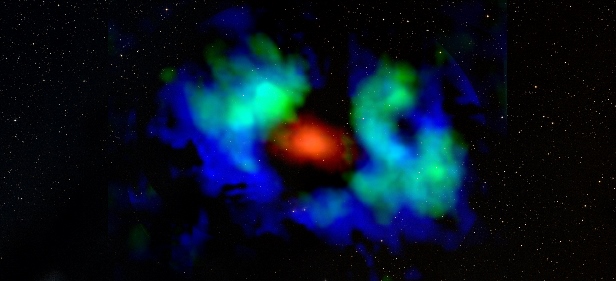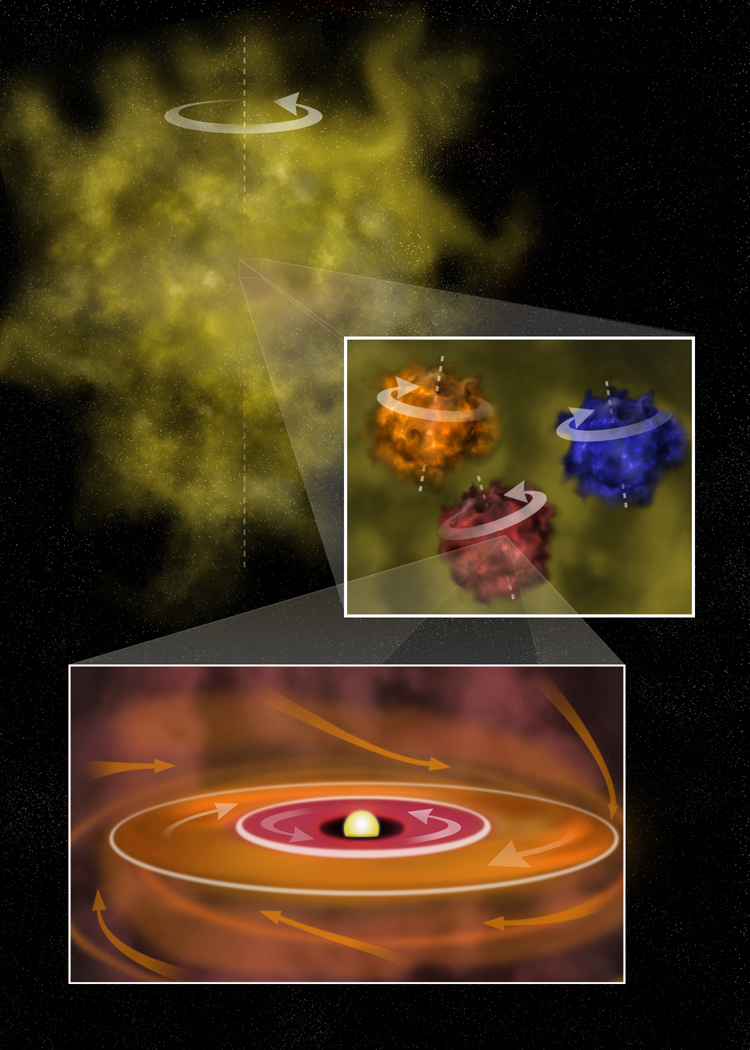Planets form before their host star matures
This discovery comes from observations of the developing star TMC1A, located in the constellation Taurus

Red are areas with many dust particles. Green and blue are two types of carbon monoxide. The absence of green / blue carbon monoxide in the inner part indicates that dust particles in the young protoplanetary disk. Image credit: Jørgensen/Harsono/ESASky/ESAC
A European team of astronomers has discovered that dust particles around a star already coagulate before the star is fully grown. Dust particle growth is the first step in the formation of planets. The researchers from the Netherlands, Sweden and Denmark publish their findings in Nature Astronomy.
In recent years, astronomers have discovered numerous planetary systems around other stars. Almost every star is likely to have at least one planet orbiting it. Some of the major questions are centred around how planetary systems form and how this process leads to the observed diversity of planets in numbers and masses. The results of a European research project suggest that planet formation starts very early in the star formation process.
The researchers used the Atacama Large Millimetre Array (ALMA) for their discovery. ALMA is a collection of 66 linked radio telescopes spread over 16 kilometres in the Atacama desert in Chile. The researchers pointed the telescope toward TMC1A, a still-developing star in the constellation Taurus (the Bull).
The astronomers saw a striking lack of carbon monoxide radiation in a disc-shaped area near the star. They suspected that the radiation was blocked by big dust particles. Using numerical models, they could demonstrate that indeed the dust particles in the young protoplanetary disk have probably grown from a thousandth of a millimetre to a millimetre.

From top to bottom shows the stages of stellar and planetary formation. From a cloud of dust and gas forms grains of material which eventually evolves into a protostar and protoplanetary disk. Image credit: B. Saxton/NRAO/AUI/NSF
Daniel Harsono of the Leiden University, the Netherlands, explains why this is so surprising. “The results indicate that planets already start forming while the star is still developing. The star is only half to three-quarters of its final mass. This is new.”
Per Bjerkeli of the Chalmers University, Sweden, highlights the implication of early grain growth. “It can be an explanation for the formation of giant planets that are comparable to Jupiter and Saturn. Only early protoplanetary discs contain sufficient mass to form giant planets.”
Matthijs van der Wiel of ASTRON, Netherlands Institute for Radio Astronomy, is pleased with the clear and unambiguous observations. “This early particle growth could be an exception, of course. Maybe this young disk is very special.”
In the future, the researchers want to look for tell-tale signs of planet formation around other protostars in similar manner. Ultimately, the astronomers want to know more about when and how planets are formed.

Keep up to date with the latest reviews in All About Space – available every month for just £4.99. Alternatively you can subscribe here for a fraction of the price!




